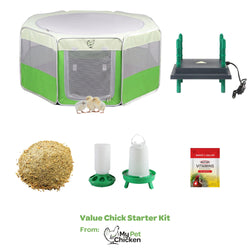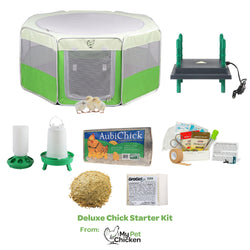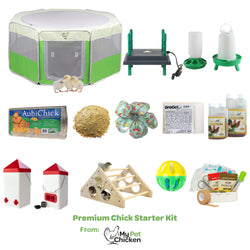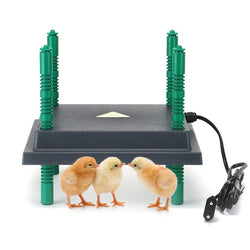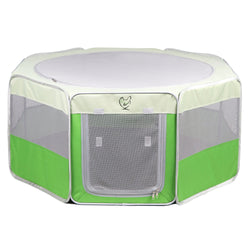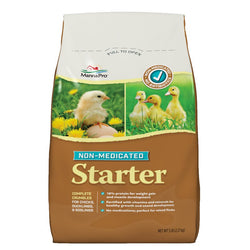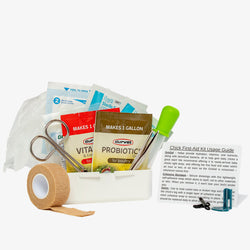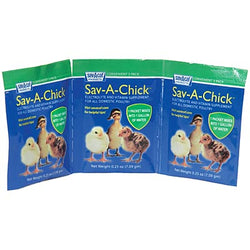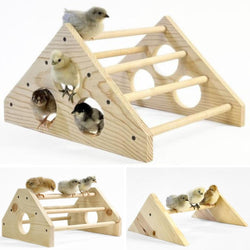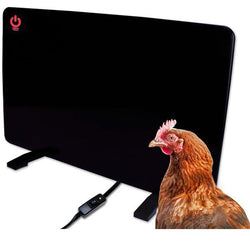All about Avian Influenza (AI)
Back to blog
The idea of "Bird Flu" (Avian Influenza), also known as AI, or Avian Flu, may strike fear in the minds of chicken keepers because of past outbreaks. When fear is involved, it is difficult to think rationally, so it's a good idea to get informed! Knowledge is power, right? The Centers for Disease Control remind us that "No animal or human infections with Asian H5N1 virus have occurred in the United States," and the USDA reminds us that in the United States, the 2022 strain of Eurasian H5 Avian Influenza has not infected any human. The major concern for backyard chicken keepers is simply prevention (see below for more on this).
Prevalence
Dangerous types, also known as �highly pathogenic� (HPAI), are generally rare in the US. The 2022 strain found in several U.S. states is known as �highly pathogenic Eurasian H5 Avian Influenza.�
Signs and Symptoms
Low Pathogenic Avian Influenza (LPAI) may occasionally present no symptoms, or very mild symptoms. Respiratory symptoms include coughing, sneezing, darkened comb/wattles, swelling of the head/eyes, and nasal discharge. Other symptoms include lethargy, loose droppings and a drop in laying. With HPAI, sudden death can occur. Read more about signs and symptoms on the USDA�s AI page.
Diagnosis
AI is diagnosed via Lab ID. If you are concerned your flock may have HPAI, you should report that to your veterinarian, the local extension office for your state�s college of agriculture, or directly to the USDA, whose veterinarians operate a toll-free hotline (1-866-536-7593).
Communicability
To other birds: highly communicable.
To humans: while technically we could potentially be vulnerable to various high pathogenic types, this has never happened in the US. HPAI has been detected five times in U.S. poultry: in 1924, 1983, 2004, 2015 and 2022. The 2004 outbreak was quickly eradicated, as was the 2015 outbreak. No human illness resulted from any of these outbreaks.
Incubation period
Your birds may show signs of infection with Avian Influenza in as little as a few hours to three or four days post-contact.
Prevention of Avian Influenza
Practice good biosecurity. Make sure to quarantine any birds showing signs of respiratory infection.
Visit the USDA's poultry biosecurity resource to learn more. We also like this handy guide published by the PA Department of Agriculture.
How to treat birds ill with Avian Influenza
There is no treatment at this time, either for HPAI (dangerous) or LPAI (mild) strains. But your course of action as a backyard chicken keeper is highly variable depending on which strain your flock contracts.
LPAI: Quarantine birds you suspect may be ill. Make sure they are not subject to other stressors that can increase mortality. For instance, make sure sick birds have access to an area that is sufficiently warm (or cool), that they have plenty of fresh water and food, and that they don't suffer from internal or external parasites.
HPAI: If you know your bird is ill with HPAI, that means you or your veterinarian had an ill or dead bird sent to the lab for analysis. The USDA will be notified, and officials will come to your farm and cull your flock immediately. There is no treatment for HPAI, and no bird on your farm will be spared. Culling is the only way to prevent spread of the disease to nearby farms and flocks. While it may seem cruel, culling birds with confirmed infection may save the lives of thousands or even millions of other birds, and therefore is the only responsible course of action.
Veterinary care
For LPAI, a vet may prescribe antibiotics to stave off secondary infections while birds recover; however, no medication exists for the avian flu virus itself. HPAI and some subtypes of LPAI are reportable illnesses, meaning the USDA must be notified in order to prevent large outbreaks.
Recovery
Most birds with LPAI recover, but mortality can approach 100% with HPAI, or even with a low pathogenic strain if the birds are stressed for some other reason.
Other conditions, illnesses and/or diseases with similar signs:
Can be mistaken for other respiratory infections or conditions like Coryza, CRD, Newcastle, or Laryngotracheitis.
Also consider browsing through this list of other chicken illnesses with respiratory symptoms.
Prevalence
Dangerous types, also known as �highly pathogenic� (HPAI), are generally rare in the US. The 2022 strain found in several U.S. states is known as �highly pathogenic Eurasian H5 Avian Influenza.�
Signs and Symptoms
Low Pathogenic Avian Influenza (LPAI) may occasionally present no symptoms, or very mild symptoms. Respiratory symptoms include coughing, sneezing, darkened comb/wattles, swelling of the head/eyes, and nasal discharge. Other symptoms include lethargy, loose droppings and a drop in laying. With HPAI, sudden death can occur. Read more about signs and symptoms on the USDA�s AI page.
Diagnosis
AI is diagnosed via Lab ID. If you are concerned your flock may have HPAI, you should report that to your veterinarian, the local extension office for your state�s college of agriculture, or directly to the USDA, whose veterinarians operate a toll-free hotline (1-866-536-7593).
Communicability
To other birds: highly communicable.
To humans: while technically we could potentially be vulnerable to various high pathogenic types, this has never happened in the US. HPAI has been detected five times in U.S. poultry: in 1924, 1983, 2004, 2015 and 2022. The 2004 outbreak was quickly eradicated, as was the 2015 outbreak. No human illness resulted from any of these outbreaks.
Incubation period
Your birds may show signs of infection with Avian Influenza in as little as a few hours to three or four days post-contact.
Prevention of Avian Influenza
Practice good biosecurity. Make sure to quarantine any birds showing signs of respiratory infection.
Visit the USDA's poultry biosecurity resource to learn more. We also like this handy guide published by the PA Department of Agriculture.
How to treat birds ill with Avian Influenza
There is no treatment at this time, either for HPAI (dangerous) or LPAI (mild) strains. But your course of action as a backyard chicken keeper is highly variable depending on which strain your flock contracts.
LPAI: Quarantine birds you suspect may be ill. Make sure they are not subject to other stressors that can increase mortality. For instance, make sure sick birds have access to an area that is sufficiently warm (or cool), that they have plenty of fresh water and food, and that they don't suffer from internal or external parasites.
HPAI: If you know your bird is ill with HPAI, that means you or your veterinarian had an ill or dead bird sent to the lab for analysis. The USDA will be notified, and officials will come to your farm and cull your flock immediately. There is no treatment for HPAI, and no bird on your farm will be spared. Culling is the only way to prevent spread of the disease to nearby farms and flocks. While it may seem cruel, culling birds with confirmed infection may save the lives of thousands or even millions of other birds, and therefore is the only responsible course of action.
Veterinary care
For LPAI, a vet may prescribe antibiotics to stave off secondary infections while birds recover; however, no medication exists for the avian flu virus itself. HPAI and some subtypes of LPAI are reportable illnesses, meaning the USDA must be notified in order to prevent large outbreaks.
Recovery
Most birds with LPAI recover, but mortality can approach 100% with HPAI, or even with a low pathogenic strain if the birds are stressed for some other reason.
Other conditions, illnesses and/or diseases with similar signs:
Can be mistaken for other respiratory infections or conditions like Coryza, CRD, Newcastle, or Laryngotracheitis.
Also consider browsing through this list of other chicken illnesses with respiratory symptoms.

